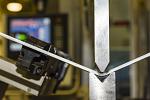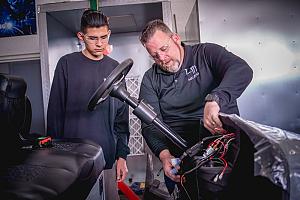President
- FMA
- The Fabricator
- FABTECH
- Canadian Metalworking
Categories
- Additive Manufacturing
- Aluminum Welding
- Arc Welding
- Assembly and Joining
- Automation and Robotics
- Bending and Forming
- Consumables
- Cutting and Weld Prep
- Electric Vehicles
- En Español
- Finishing
- Hydroforming
- Laser Cutting
- Laser Welding
- Machining
- Manufacturing Software
- Materials Handling
- Metals/Materials
- Oxyfuel Cutting
- Plasma Cutting
- Power Tools
- Punching and Other Holemaking
- Roll Forming
- Safety
- Sawing
- Shearing
- Shop Management
- Testing and Measuring
- Tube and Pipe Fabrication
- Tube and Pipe Production
- Waterjet Cutting
Industry Directory
Webcasts
Podcasts
FAB 40
Advertise
Subscribe
Account Login
Search
How do you measure your shop’s performance?
Operational effectiveness and efficiency measurements can help you to measure the progress of manufacturing decisions
- By Bill Frahm
- February 16, 2017
- Article
- Shop Management
Your plant's performance depends on reliable and efficient processes and equipment. Operational effectiveness and efficiency (OEE) is a comprehensive measure of equipment efficiency and an indicator of progress toward improvement.
OEE is a comparative measure. A series of OEE values over time can help you identify manufacturing and equipment operations with possible issues that need additional attention. Your series of periodic measurements also provides input on your process improvement activities.
Used properly, OEE can provide valuable feedback on the effectiveness of your maintenance, design for manufacturability efforts, and production operations. By itself, OEE offers little insight or value in identifying root causes and opportunities for improvement. The components of OEE—availability, performance, and quality—offer direction to possible causes for underperforming assets and bottlenecks.
What OEE Is
“Do not put faith in what statistics say until you have carefully considered what they do not say.” – William W. Watt
Numerous variables influence the effectiveness and quality of your production results. You must be aware of the influences of your design, material, and manufacturing decisions to identify the causes of unacceptable performance. Obviously, comprehensive awareness and understanding will help your team make better decisions before production begins.
OEE is simply a way to assign a numerical score to your equipment operations, identify opportunities for improvement, and measure your progress. The OEE value is the factor of these components:
- Availability measures the percentage of planned operating time that the machine is available to produce. The machine’s available time is measured as: Planned Operating Time – Downtime for Maintenance and Adjustment. Availability is calculated as: Available Time/Scheduled Operating Time.
- Performance measures the actual output of the machine as a percentage of a standardized output expectation. Performance is calculated as: Actual Output/Standard Output.
- Quality measures the percentage of acceptable parts against total production of the machine. Quality is calculated as: Right First Time Output/Total Output.
Once the availability, performance, and quality ratios are calculated, OEE is calculated as: Availability X Performance Quality.
How OEE Works
As a rule, OEE measures the effects of the “six big losses” of total productive maintenance. The six big losses (see Figure 1) are considered to be among the most common reasons for lost productivity in manufacturing.
Most of these types of losses are self-explanatory. However, it should be noted that production failures also may indicate a need to evaluate your maintenance program, design for manufacturability process, training, equipment selection, or materials.
OEE is a valuable indicator that issues may exist. The numbers, however, don't tell you what the issues are. This is where you should use your experience in failure modes and effects analysis and root cause analysis to find the source of the problem and begin fixing the underlying causes.

Figure 1. These “six big losses,” as defined by the total productive maintenance philosophy, apply not only to metal manufacturing operations, but are also common across most discrete manufacturing.
If you use reliability centered maintenance (RCM), OEE provides valuable information about equipment that may be underperforming. Excessive downtime and overcycling conditions may identify opportunities to improve your predictive maintenance plans.
Design for manufacturability should be used to consider the capabilities and limitations of your manufacturing operations in design. For example, necessary tonnage for a selected material, your experience with tooling steels, heating and transfer equipment capabilities, and other production capabilities all influence your experience with handling and forming blanks into quality product. If production capabilities are not accounted for during design, they can negatively affect maintenance intervals and cycle times.
Training and awareness of the variables in your manufacturing processes are also critical for understanding what an undesirable OEE value is telling you.
Doing OEE Right
Many dynamic manufacturing and design decisions influence your OEE results. Because OEE indicates the sum of these decisions, it can be confusing to understand without adequate research and understanding.
OEE is similar to the “Check Engine” light on your car. It can indicate a problem, but you must look further to identify the source of the problem. Some of the most common misuses of OEE are:
- Using a single OEE measure as an evaluation. OEE must be taken in its own context as a comparative measure over a period of time. The number itself has no meaning until compared with prior measures. OEE is merely an indicator of where a problem lies and a measure of progress in improving the underlying issue.
- Calculating OEE for too many or too few pieces of equipment.
- Using “world-class” measures as targets.
- Using OEE to punish employees.
- Using OEE as an external measure.
OEE is a valuable tool for identifying opportunities to improve your equipment-related decisions. Used properly, it can begin a journey to optimize maintenance, design for manufacturability efforts, production, and other manufacturing processes.
Beware, though. If misunderstood and used improperly, OEE can be harmful and disdained by your employees.
About the Author

Bill Frahm
P.O. Box 71191
Rochester Hills, MI 48307
248-506-5873
subscribe now

The Fabricator is North America's leading magazine for the metal forming and fabricating industry. The magazine delivers the news, technical articles, and case histories that enable fabricators to do their jobs more efficiently. The Fabricator has served the industry since 1970.
start your free subscription- Stay connected from anywhere

Easily access valuable industry resources now with full access to the digital edition of The Fabricator.

Easily access valuable industry resources now with full access to the digital edition of The Welder.

Easily access valuable industry resources now with full access to the digital edition of The Tube and Pipe Journal.
- Podcasting
- Podcast:
- The Fabricator Podcast
- Published:
- 05/14/2024
- Running Time:
- 62:12
Cameron Adams of Laser Precision, a contract metal fabricator in the Chicago area, joins the podcast to talk...
- Trending Articles
Why employee-owned companies make sense in manufacturing

Nucor’s weekly steel price announcement continues to rattle markets

What software automation means for custom fabrication

Press brakes, panel benders, and flat blank calculations

7-axis cobots have controller integrated into the base

- Industry Events
Laser Welding Certificate Course
- May 7 - August 6, 2024
- Farmington Hills, IL
World-Class Roll Forming Workshop
- June 5 - 6, 2024
- Louisville, KY
Advanced Laser Application Workshop
- June 25 - 27, 2024
- Novi, MI
Precision Press Brake Certificate Course
- July 31 - August 1, 2024
- Elgin,



























